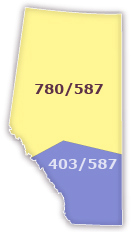Lesson 1: Fundamental Counting Principle
Focus

Comstock/Thinkstock
One of the ways people are identified is by phone numbers. In the not-too-distant past, one phone number was often associated with an entire family. Now, however, many people possess individual cellphones and their own unique phone numbers.
Prior to 1999, the area code for the entire province of Alberta was 403. In 1999, the southern half of the province retained the 403 area code, and the northern half was assigned the new area code of 780. In September 2008, Alberta added another area code, 587, across the province as available phone numbers were again running out. By adding another area code there is a potential for nine million more phone numbers.

Adapted from base map
© Map Resources
Can you think why people in Alberta continue to need more phone numbers? By the end of this lesson you will be able to show that a new area code does indeed amount to nine million new phone numbers.
Determining the number of ways things may occur is a branch of mathematics called combinatorics. This branch is used in many ways: from designing a computer network to coding your garage door opener to determining the chances of winning the lottery.
Lesson Outcomes
At the end of this lesson you will be able to
- use the fundamental counting principle to solve problems
- use a new notation, called factorial notation, to determine the number of arrangements of items
Lesson Questions
You will investigate the following questions:
- How can you use the fundamental counting principle to determine the number of outcomes in a given problem?
- What is factorial notation and when is it used to solve problems?
Assessment
Your assessment may be based on a combination of the following tasks.
- completion of the Lesson 1 Assignment (Download the Lesson 1 Assignment and save it in your course folder now.)
- course folder submissions from Try This and Share activities
- additions to Glossary Terms and Formula Sheet
- work under Project Connection
Self-Check activities are for your own use. You can compare your answers to suggested answers to see if you are on track. If you are having difficulty with concepts or calculations, contact your teacher.
Remember that the questions and activities you will encounter provide you with the practice and feedback you need to successfully complete this course. You should complete all questions and place your responses in your course folder. Your teacher may wish to view your work to check on your progress and to see if you need help.
Time
Each lesson in Mathematics 30-1 LearnEveryware is designed to be completed in approximately two hours. You may find that you require more or less time to complete individual lessons. It is important that you progress at your own pace, based on your individual learning requirements.
This time estimation does not include time required to complete Going Beyond activities or the Module Project.